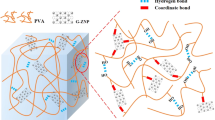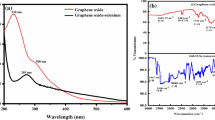Abstract
Two series of pH-sensitive poly (N-vinyl imidazole)/nitrogen-doped graphene quantum dots nanocomposite hydrogels (PVI/NGQD) were synthesized successfully via an in situ polymerization approach. The polymerization was carried out with different feeding ratios of N-vinyl imidazole (0.75–2.00 mol/L), MBA (N,N′- methylene-bis-acrylamide) (0.02–0.18 mol/L) or DIL (3,3′ -divinyl-1,1′ (1,6-hexanediyl) di-imidazolium dibromide) (0.05–0.08 mol/L) as a crosslinker in the presence of NGQD nanoparticles (0.3–1.0 wt%) at 70 °C for 7 h. The pH-dependent swelling behavior was improved for DIL-based PVI/NGQD by increasing the contents of VI and NGQDs, while an increase in crosslinker value led to a reduced swelling degree. XRD and TGA results showed that the incorporation of NGQDs in hydrogel networks could increase the crystallinity and thermal stability of resultant PVI/NGQD nanocomposite. SEM images showed clear changes in surface morphology after incorporation of the NGQDs within the PVI hydrogel matrix, resulting in more porous network channels. Mechanical examinations indicated that MBA-based PVI/NGQD has higher compressive stress and Young’s modulus, which improves with increasing NGQDs content due to increase in crosslinking density of nanocomposite. Therefore, MBA-based hydrogels become stiffer and more brittle than less-strength elastic DIL-based hydrogels. The prepared PVI/NGQD nanocomposite exhibited significant antibacterial activity against Gram-negative bacteria. In addition, the results showed that NGQDs and ionic DIL crosslinker have improved the antibacterial activity of PVI/NGQD hydrogels and decreased the degradation process. Finally, cell proliferation and cytotoxicity studies represented that these nanocomposite hydrogels can be considered as a potential candidate for biomedical applications.









Similar content being viewed by others
References
Buwalda SJ, Boere KW, Dijkstra PJ, Feijen J, Vermonden T, Hennink WE (2014) Hydrogels in a historical perspective: From simple networks to smart materials. J Control Release 190:254–273
Maitra J, Shukla VK (2014) Cross-linking in hydrogels-a review. Am J Polym Sci 4:25–31
Chirani N, Yahia L, Gritsch L, Motta FL, Chirani S, Farè S (2015) History and applications of hydrogels. J Biomed Sci 4:1–23
Hunt JN, Feldman KE, Lynd NA, Deek J, Campos LM, Spruell JM, Hernandez BM, Kramer EJ, Hawker CJ (2011) high modulus hydrogels driven by ionic coacervation. Adv Mater 23:2327–2331
Ahmed EM (2015) Hydrogel: Preparation, characterization, and applications: a review. J Adv Res 6:105–121
Rizwan M, Yahya R, Hassan A, Yar M, Azzahari AD, Selvanathan V, Sonsudin F, Abouloula CN (2017) pH sensitive hydrogels in drug delivery: Brief history, properties, swelling, and release mechanism, material selection and applications. Polymers 9:137
Hendi A, Hassan MU, Elsherif M, Alqattan B, Park S, Yetisen AK, Butt H (2020) Healthcare applications of pH-sensitive hydrogel-based devices: a review. Int J Nanomedicine 15:3887
Soliman SMA, Sanad MF, Shalan AE (2021) Synthesis, characterization and antimicrobial activity
Cheng L, Zhang PB, Zhao YF, Zhu LP, Zhu BK, Xu YY (2015) Preparation and characterization of poly (N-vinyl imidazole) gel-filled nanofiltration membranes. J Membr Sci 492:380–391
Sabaa MW, Mohamed NA, Mohamed RR, Khalil NM, Abd El Latif SM (2010) Synthesis, characterization and antimicrobial activity of poly (N-vinyl imidazole) grafted carboxymethyl chitosan. Carbohydr Polym 79:998–1005
Singh B, Kumar A (2018) Radiation-induced graft copolymerization of N-vinyl imidazole onto moringa gum polysaccharide for making hydrogels for biomedical applications. Int J Biol Macromol 120:1369–1378
Sabaa MW, Mohamed ME, Abdellatif MM, Soliman SM (2020) Antibacterial effect of novel grafted gelatin on gram-negative bacteria. Polym Bull 77:427–440
Mohamed RR, Elella MHA, Sabaa MW, Saad GR (2018) Synthesis of an efficient adsorbent hydrogel based on biodegradable polymers for removing crystal violet dye from aqueous solution. Cellulose 25:6513–6529
Kizhnyaev V, Petrova T, Pokatilov F, Zhitov R, Edel’shtein O, (2014) Synthesis of network poly (N-vinylimidazole) and properties of the related hydrogels. Polym Sci Ser B 56:645–649
Vives CM, Pastoriza A (2015) Poly (N-vinyl imidazole) hydrogels polymerized in molds of different materials. Eur Polym J 73:26–37
Mohamed RR, Seoudi RS, Sabaa MW (2012) Synthesis and characterization of antibacterial semi-interpenetrating carboxymethyl chitosan/poly (acrylonitrile) hydrogels. Cellulose 19:947–958
Gaharwar AK, Peppas NA, Khademhosseini A (2014) Nanocomposite hydrogels for biomedical applications. Biotechnol Bioeng 111:441–453
Ali A, Ahmed S (2018) A review on chitosan and its nanocomposites in drug delivery. Int J Biol Macromol 109:273–286
Vashist A, Kaushik A, Ghosal A, Bala J, Nikkhah-Moshaie R, Wani WA, Manickam P, Nair M (2018) Nanocomposite hydrogels: advances in nanofillers used for nanomedicine. Gels 4:75–90
Lu H, Zhang S, Guo L, Li W (2017) Applications of graphene-based composite hydrogels: a review. RSC Adv 7:51008–51020
Phan LMT, Vo TAT, Hoang TX, Cho S (2021) Graphene integrated hydrogels based biomaterials in photothermal biomedicine. Nanomaterials 11:906–934
Bagheri M, Mahmoodzadeh A (2020) Polycaprolactone/graphene nanocomposites: synthesis, characterization and mechanical properties of electrospun nanofibers. J Inorg Organomet Polym Mater 30:1566–1577
Rakhshaei R, Namazi H, Hamishehkar H, Rahimi M (2020) Graphene quantum dot cross-linked carboxymethyl cellulose nanocomposite hydrogel for pH-sensitive oral anticancer drug delivery with potential bioimaging properties. Int J Biol Macromol 150:1121–1129
Jampilek J, Kralova K (2021) Advances in drug delivery nanosystems using graphene-based materials and carbon nanotubes. Materials 14:1059–1098
Afshar EG, Zarrabi A, Dehshahri A, Ashrafizadeh M, Dehghannoudeh G, Behnam B, Mandegary A, Pardakhty A, Mohammadinejad R, Tavakol S (2020) Graphene as a promising multifunctional nanoplatform for glioblastoma theranostic applications. FlatChem 22:100173
Lee HJ, Yook JG (2019) Graphene nanomaterials-based radio-frequency/microwave biosensors for biomaterials detection. Materials 12:952
Sarabiyan Nejad S, Rezaei M, Bagheri M (2020) Polyurethane/Nitrogen-Doped Graphene Quantum Dot (N-GQD) nanocomposites: synthesis, characterization, thermal, mechanical and shape memory properties. Polym-Plast Technol Mater 59:398–416
Javanbakht S, Shaabani A (2019) Encapsulation of graphene quantum dot-crosslinked chitosan by carboxymethylcellulose hydrogel beads as a pH-responsive bio-nanocomposite for the oral delivery agent. Int J Biol Macromol 123:389–397
Havanur S, Jagadeeshbabu P (2018) Role of graphene quantum dots synthesized through pyrolysis in the release behavior of temperature responsive poly (N, N-diethyl acrylamide) hydrogel loaded with doxorubicin. Int J Polym Anal Charact 23:606–620
Xu Q, Ji Y, Sun Q, Fu Y, Xu Y, Jin L (2019) Fabrication of cellulose nanocrystal/chitosan hydrogel for controlled drug release. Nanomaterials 9:253
Khabibullin A, Alizadehgiashi M, Khuu N, Prince E, Tebbe M, Kumacheva E (2017) Injectable shear-thinning fluorescent hydrogel formed by cellulose nanocrystals and graphene quantum dots. Langmuir 33:12344–12350
Massoudi S, Bagheri M, Hosseini M (2022) Poly (N-vinyl imidazole)/nitrogen doped graphene quantum dot nanocomposite hydrogel as an efficient metal ion adsorbent from aqueous systems. Iran Polym J 31:533–551
Hebeish A, Sharaf S (2015) Novel nanocomposite hydrogel for wound dressing and other medical applications. RSC adv 5:103036–103046
Khan AS, Man Z, Arvina A, Bustam MA, Nasrullah A, Ullah Z, Sarwono A, Muhammad N (2017) Dicationic imidazolium based ionic liquids: synthesis and properties. J Mol Liq 227:98–105
Xu X, Bai B, Ding C, Wang H, Suo Y (2015) Synthesis and properties of an ecofriendly superabsorbent composite by grafting the poly (acrylic acid) onto the surface of dopamine-coated sea buckthorn branches. Ind Eng Chem Res 54:3268–3278
Xie Y, Cheng D, Liu X, Han A (2019) Green Hydrothermal synthesis of N-doped carbon dots from biomass highland barley for the detection of Hg2+. Sensors 19:3169–3182
Sharma A, Wilson GR, Dubey A (2016) Antibacterial activity of vinyl imidazole (VI) functionalized silica polymer nanocomposites (SBA/VI) against Gram negative and Gram positive bacteria. New J Chem 40:764–769
Hu F, Fang C, Wang Z, Liu C, Zhu B, Zhu L (2017) Poly (N-vinyl imidazole) gel composite porous membranes for rapid separation of dyes through permeating adsorption. Sep Purif Technol 188:1–10
Arthisree D, Joshi GM (2017) Study of polymer graphene quantum dot nanocomposites. J Mater Sci: Mater Electron. https://doi.org/10.1007/s10854-017-6825-6
Zhao X, Gao W, Zhang H, Qiu X, Luo Y (2020) Graphene quantum dots in biomedical applications: recent advances and future challenges. In: Handbook of nanomaterials in analytical chemistry. pp 493–505
Obando-Mora Á, Acevedo-Gutiérrez CA, Pérez-Cinencio JG, Sánchez-Garzón FS, Bucio E (2015) Synthesis of a pH-and thermo-responsive binary copolymer poly (N-vinylimidazole-co-N-vinylcaprolactam) grafted onto silicone films. Coatings 5:758–770
Porfarzollah A, Mohammad-Rezaei R, Bagheri M (2020) Ionic liquid-functionalized graphene quantum dots as an efficient quasi-solid-state electrolyte for dye-sensitized solar cells. J Mater Sci: Mater Electron 31:2288–2297
Patarroyo JL, Fonseca E, Cifuentes J, Salcedo F, Cruz JC, Reyes LH (2021) Gelatin-graphene oxide nanocomposite hydrogels for Kluyveromyces lactis encapsulation: potential applications in probiotics bioreactor packings. Biomolecules 11:922–931
Othman SH, Othman NFL, Shapi’i RA, Ariffin SH, Yunos KFM (2021) Corn starch/chitosan nanoparticles/thymol bio-nanocomposite films for potential food packaging applications. Polymers 13:390–409
Jiao C, Zhang G, Liu T, Peng X, Wang H (2020) Mechanically strong, tough and shape deformable poly(acrylamide- co -vinyl imidazole) hydrogels based on Cu 2+ complexation. ACS Appl Mater Interfaces 12:44205–44214
Ganji F, Vasheghani FS, Vasheghani FE (2010) Theoretical description of hydrogel swelling: a review. Iran Polym J 19:375–398
Javanbakht S, Namazi H (2018) Doxorubicin loaded carboxymethyl cellulose/graphene quantum dot nanocomposite hydrogel films as a potential anticancer drug delivery system. Mater Sci Eng C 87:50–59
Ding H, Zhang XN, Zheng SY, Song Y, Wu ZL, Zheng Q (2017) Hydrogen bond reinforced poly (1-vinylimidazole-co-acrylic acid) hydrogels with high toughness, fast self-recovery, and dual pH-responsiveness. Polymer 131:95–103
Kim JH, Li Y, Kim MS, Kang SW, Jeong JH, Lee DS (2012) Synthesis and evaluation of biotin-conjugated pH-responsive polymeric micelles as drug carriers. Int J Pharm 427:435–442
Zhao X, Lang Q, Yildirimer L, Lin ZY, Cui W, Annabi N, Ng KW, Dokmeci MR, Ghaemmaghami AM, Khademhosseini A (2016) Photocrosslinkable gelatin hydrogel for epidermal tissue engineering. Adv Healthc Mater 5:108–118
Omer RA, Hama JR, Rashid RSM (2017) The effect of dextran molecular weight on the biodegradable hydrogel with oil, synthesized by the michael addition reaction. Adv in Polym Technol 36:120–127
Dharmalingam K, Bordoloi D, Kunnumakkara AB, Anandalakshmi R (2020) Preparation and characterization of cellulose-based nanocomposite hydrogel films containing CuO/Cu2O/Cu with antibacterial activity. Adv Polym Technol 137:49216
Bagheri M, Shateri S, Niknejad H, Entezami AA (2014) Thermosensitive biotinylated hydroxypropyl cellulose-based polymer micelles as a nano-carrier for cancer-targeted drug delivery. J Polym Res 21:1–15
Kim CH, Khil MS, Kim HY, Lee HU, Jahng KY (2006) An improved hydrophilicity via electrospinning for enhanced cell attachment and proliferation. J Biomed Mater Res Part B: Appl Biomater 78:283–290
Wang W, Caetano G, Ambler WS, Blaker JJ, Frade MA, Mandal P, Diver C, Bártolo P (2016) Enhancing the hydrophilicity and cell attachment of 3D printed PCL/graphene scaffolds for bone tissue engineering. Materials 9:992–1003
Author information
Authors and Affiliations
Corresponding author
Ethics declarations
Conflict of interest
The authors declare no conflict of interest.
Additional information
Publisher's Note
Springer Nature remains neutral with regard to jurisdictional claims in published maps and institutional affiliations.
Rights and permissions
About this article
Cite this article
Massoudi, S., Bagheri, M., Beygi Khosrowshahi, Y. et al. Antibacterial and cytotoxicity assessment of poly (N-vinyl imidazole)/nitrogen-doped graphene quantum dot nanocomposite hydrogels. Polym. Bull. 80, 6471–6494 (2023). https://doi.org/10.1007/s00289-022-04371-3
Received:
Revised:
Accepted:
Published:
Issue Date:
DOI: https://doi.org/10.1007/s00289-022-04371-3




